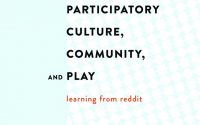Vol. 6.3: Special Issue on the Rhetoric of Platforms
The Rhetorics of Platforms: Definitions, Approaches, Futures
Origins are always fuzzy, but concrete ideas about the focus of this special issue, “The Rhetorics of Platforms,” began around mid 2016. The year, not yet half way over, was already marked by tumultuous uncertainty worldwide. As Brexit and other nationalist sentiments were growing in Europe, a toxic presidential campaign was underway in the United States. These and other global events certainly shaped the critical angle we wanted to explore with this special issue, but we must confess that we had much more disciplinary—much more banal, even—aspirations when putting together the call that eventually led to the publication of this issue. We saw a growing need for rhetoric and writing scholars to theorize, study, and account for how digital platforms shape rhetorical activity and, in turn, how platforms themselves are rhetorical forces in the world. At around the midpoint of 2016, then, we wanted to pose a fairly straightforward question: what methodological approaches might rhetoricians construct and employ to study the rhetorical work of platforms?
And then Donald Trump was elected. Immediately following, a number of journalistic, academic, and community efforts attempted to come to grips with what happened and how. In many accounts, automated and computational aspects of digital platforms took center stage: algorithms helped construct filter bubbles and echo chambers, bots spread misinformation and supplied false metrics of popularity, and automated procedures failed to keep silencing mechanisms like harassment at bay. The question of responsibility—about the extent to which platforms should be held accountable for the role they play in political and social manipulations—seemed to reach a tipping point toward the end of 2016 (see, for example, The Computational Propaganda Project; Data and Society’s Media Manipulation and Disinformation Online; and, closer to our own discipline, Literacy in Composition Studies’ recent special issue on “Literacy, Democracy, and Fake News”).
While 2016 may serve as a watershed moment for interrogating the rhetorics of digital platforms, we still see the exigency for this special issue as being more of a slow burn rather than any single distinguishable moment or event. Mounting concerns about the power and responsibility of digital platforms have been piling up for years, including issues related to algorithmic discrimination and oppression (Noble), circulation gatekeeping (Edwards), content moderation (Roberts), toxic platform cultures (Gruwell; Massanari; Sparby), and other platform interventions (Gillespie, “Platforms Intervene”). To this end, the presumed neutrality of platforms has long been called into question. For example, in his landmark publication, “The Politics of Platforms,” Tarleton Gillespie unravels how social media companies have leveraged the term “platform” to cater to multiple stakeholders at once. A platform, Gillespie argues, can simultaneously align itself with different aims: it can be a platform for advertisers to reach potential buyers and a platform from which everyday users can speak or write. A platform can be understood in a highly technical sense and in a metaphorical sense. Such slippage helps maintain an illusion of neutrality. Although platforms host and circulate content they do not produce, it would be a mistake to see them as mere intermediaries. Platforms grant access, but they also set the conditions for that access. Platforms promise to be catalysts for public participation, but they also mask their role in facilitating or occluding that participation. Platforms make decisions, but they often downplay, obfuscate, and/or black box those decisions.
Of course, rhetoric and composition scholars have long argued that technology is never neutral, passive, or innocent (e.g., Arola; Banks; Gruwell; Janangelo; Wysocki and Jasken).1 Consider, for example, a trio of articles that questioned the politics of particular software developments in the 1990’s and early 2000’s. In 1994, Cynthia Selfe and Richard Selfe published their influential article, “The Politics of the Interface: Power and Its Exercise in Electronic Contact Zones,” which uncovered how computer interfaces reinscribe legacies of domination and colonialism through their “default” designs. Five years later, in 1999, Joel Haefner extended Selfe and Selfe’s work by examining the politics of computer code, arguing that code represents “a new kind of cultural imperialism” (325). And in 2002, Tim McGee and Patricia Ericsson pointed out the cultural politics embedded in one particular program, Microsoft Word. In all, such attention to the politics of interfaces, code, and programs seeks to question the assumptions, biases, and erasures that are embedded in technologies and our everyday use with them.
Contributions to this special issue follow such work to consider new rhetorical contexts we currently face on platforms: from the politics of the interface, code, and program, to the politics—and the rhetorics—of the platform. Responding to a number of platforms (Facebook, Twitter, Snapchat, Yik Yak, and Grindr), as well as a number of issues (researcher positionality, algorithms, agency, design, ethics, and search), the work featured here pursues the question of the platform from multiple angles and subjectivities. Authors consider platforms from overlapping and sometimes competing standpoints—from, for example, corporate entities whose black-boxed activities demand reconfigured understandings of rhetorical terms like kairos and rhetorical velocity, to meta or “supra” platforms that discursively connect participants to some larger, loosely defined goal or activity. Before introducing individual contributions to the special issue, we want to provide definitions that we hope will help frame the discussions that follow.
Platform Rhetorics
Digital platforms are complex and ever-evolving social, technological, economic, cultural, and political configurations. Platforms include those corporate giants that need little to no introduction, including Facebook, Apple, Google, and Amazon. But platforms also reach across numerous public and private sectors, including hospitality (AirBnB, Yelp), transportation (Uber, Lyft), entertainment (Spotify, Netflix), lifestyle and dating (Grindr, Tinder), health and fitness (Fitbit, Garmin), education (Canvas, Coursera), and more. In effect, it’s not too bold of a claim to say platforms have changed the conditions of the web as we know it today, restructuring many taken for granted aspects of public and private life. For media theorists José Van Dijck and Thomas Poell, platforms are “online sites that facilitate and organize data streams, economic interactions, and social exchanges between users” (2). Following Van Dijck and Poell, we briefly trace the computational, economic, and social dimensions of platforms to more fully bring the term into definitional coherence.
On the computational end of the spectrum, a platform might be conceived as the infrastructural layer of computing, a meeting point of hardware, software, and culture. For Nick Montfort and Ian Bogost, to study a platform is “to investigate the hardware and software systems upon which programming takes place, the ones that are the foundation for computational expression” (2). Montfort and Bogost thus situate the platform as a layer of digital media that concerns itself with computing systems and architectures (other layers, for them, include reception, the interface, form/function, and code). Yet, they stress, “a computational platform is not an alien machine, but a cultural artifact that is shaped by values and forces and which expresses views about the world” (148). Montfort and Bogost’s attention to cultural values and forces is crucial, because it underscores that platforms are not mere computational intermediaries divorced from broader culture; they are products of culture, often taken for granted and in need of critical analysis to unconceal. Lisa Nakamura takes this claim a bit further, historicizing the invisible labor that serves a precondition to the current platform economy. For Nakamura, histories of exploitative labor in the technology manufacturing industry—often performed by women of color in low-waged and undervalued positions—are inextricable from current understandings of digital platform production. From this perspective, the call for “platforms studies” (Montfort and Bogost), and indeed the move to understand platforms from a computational dimension, is not a call to somehow forget or bracket human bodies or larger circuits of production. Rather, platforms studies seeks to dwell at the intersections of software, hardware, culture, and production.
In a more technical sense, a platform represents the infrastructure upon which new services can be built through an application programming interface (API). From this vantage point, the platform enjoys a privileged position, as platforms require those new service developers to make their programs “platform ready” (Helmond). In other words, app developers must configure their programs in such a way as to share data streams with the platform upon which it operates. For example, when an online game such as Candy Crush Saga runs on the Facebook platform, the owner of the app, Activision Blizzard, must grant Facebook access to its data. As Anne Helmond writes, “social media platforms provide a technological framework for others to build on, geared toward connecting to and thriving on other websites, apps and their data” (8). This is a fairly new model of web development that has helped a select few platforms—Facebook, Google, Amazon—dominate in the emerging platform economy.
Such technical depictions—accessing and using data streams—also help describe the economic dimension of platforms. Nick Srnicek argues that advanced capitalism today has turned to data as material to boost economic growth and vitality in the otherwise sluggish technology development sector. As the rise of Big Data indicates, data have become an increasingly important commodity (especially if collected in mass quantities). As Srnicek notes, “just like oil, data are a material to be extracted, refined, and used in a variety of ways. The more data one has, the more uses one can make of them” (40). And so describes the fundamental economic dimension of platforms: it is in their best financial interests to grow their data pools, to collect copious amounts of data that can be used for new purposes.
While citizens may actively resist participating on and with platforms, the social reach of platforms is undeniable. Indeed, platforms have thoroughly infiltrated our social and political lives, providing spaces for cultural, political, and rhetorical expression (e.g., for organizing, protest, and identity- and community-building), as well providing means to access services, earn wages, and circulate value. Yet at the same time, due to proprietary algorithms and computational procedures, everyday citizens never know for sure how the content they access is being organized nor how their information is being collected, surveilled, monetized, and circulated. As such, the task, as we see it, is to study platforms not as static technical entities but as moving assemblages with computational, economic, social, and other dimensions.
We thus foreground the notion of the rhetorics of platforms to help recognize the multidimensional suasive forces and effects of platforms. Not only are platforms rhetorical in the sense that they occupy a public imaginary that is discursively constructed via carefully crafted branding efforts, but they are also rhetorical in that their decisions produce effects in the world. Platforms are sites for rhetorical action but also determine the contours of that action. Platforms are complex and evolving assemblages of people, technologies, discourses, materialities, financial decisions, community practices, and more that shape the possibilities for social, civic, and political exchanges. Platforms, then, are rhetorical infrastructures that host and shape the production and circulation of media content.
A caveat: our description of the rhetorics of platforms may seem to downplay the human element that is always at play in these sites and services. That is not our intention. We recognize that it is humans who write the business plans, the code, and the algorithms on which platforms are built. Yet, because platforms are in a constant state of update and revision, evolving and adjusting to community and market pressures through complex computational procedures, we find the notion of assemblage to be a more useful descriptor for understanding the suasive force of platforms.
To call an entity an assemblage is to point out the impossibility of isolating discrete parts of complex systems or networks (see Edwards and Lang, for more on the material complexity of platforms). As Jodie Nicotra argues, “attuning to assemblages helps us reconceive rhetorical action as something that requires a deliberate and intentional attention to all of the elements of the system (both human and nonhuman, organic and inorganic) in which one hopes to intervene, an attention gained through repeated interaction and empirical observation and experimentation” (187-188). Assemblage thinking, as Nicotra terms it, resists the god’s eye view of understanding complex systems and phenomena: it starts, instead, in the middle, in medias res, and works to notice uneven relations as they emerge. Bringing this kind of thinking to bear on platforms is not to somehow forget humans, but to think more deeply about avenues of ethical response, a charge the authors of this special issue take up.
Volume 6 Issue 3 includes the following interview, articles, and reviews:
- “Rhetoric, Responsibility, and the Platform: An Interview with Jessica Reyman:” The guest editors of this special issue, Dustin Edwards and Bridget Gelms, engage Jessica Reyman (Northern Illinois U) about her work in intellectual property, user data, and algorithmic processes.
- “Constructing Research, Constructing the Platform: Algorithms and the Rhetoricity of Social Media Research:” Leigh Gruwell (Auburn U) argues for a greater methodological consideration of how social media platforms construct our research, and, likewise, how our research practices construct the platform, encouraging us to foreground the diverse networks of actors that mediate and create social media.
- “How To Be Gay with Locative Media: The Rhetorical Work of Grindr as a Platform:” Michael Faris (Texas Tech) explores how changes to Grindr’s interface and marketing practices have transformed the platform from a dating or hookup app to one that constructs and reinforces consumer-driven, normative gay identities.
- “Building Dark Patterns into Platforms: How GamerGate Perturbed Twitter’s User Experience:” Michael Trice (MIT) and Liza Potts (MSU) examine the rhetorical interventions of GamerGate and how this movement shaped platforms through dark patterns that encouraged and often required aggressive, hostile, and mob-like activism.
- “Corporate Kairos and the Impossibility of the Anonymous, Ephemeral Messaging Dream:” Sara West (U of Arkansas) and Adam Pope (U of Arkansas) outline the concept of “corporate kairos,” the demand of corporate members of social media platforms to circumvent the normal rules of kairos and rhetorical velocity, and demonstrate both successful and failing uses of it via Snapchat and YikYak respectively.
- “Algorithms as Information Brokers: Visualizing Rhetorical Agency in Platform Activities:” Daniel Hocutt (Old Dominion U) considers the rhetorical agency of both human and non-human actors during online search activities via digital platforms and provides methods for measuring and assessing these rhetorical agencies.
- Book Review of Adrienne L. Massanari’s Participatory Culture, Community, and Play: Learning from Reddit by Rachael Sullivan (St. Joseph’s U)
- Book Review of Cathy O’Neil’s Weapons of Math Destruction by John Silvestro (Slippery Rock U)
Together, the insights offered throughout the special issue help us to better understand multiple entry points into the rhetorics of platforms, including methodologies of platform research, identity construction via platforms, subversive rhetorical tactics that shape platform user experiences, rhetorical agencies of algorithms, platform interventions in our everyday civic lives, and more. Platforms, as authors in this special issue attest, are difficult to pin down; yet, as a term and sociotechnical configuration with growing cultural and economic capital, we believe the work of studying the rhetorics of platforms has only just begun. In assembling this special issue, we hope to inspire further conversations about platform rhetorics and what they mean for the work we do as rhetoricians, teachers, writers, and citizens.
Acknowledgements
In addition to the contributors, we thank all of the reviewers for their thoughtful, productive, and prompt feedback. We are indebted to the care they put into the review process. Additionally, we thank the editors of Present Tense, Ehren Pflugfelder and Megan Schoen, who not only accepted our special issue proposal but provided reassurance, guidance, and patience along the way. We also want to thank the readers of Present Tense. Finally, special thanks go to Jessica Reyman for her willingness to participate in an interview; her deft knowledge about forms of digital control has very much inspired this special issue.
Endnotes
- Scholars have paid critical attention to how digital platforms intersect with discussions of activism (e.g., Dadas; Lane), identity (e.g., Almjeld; Beck; Dich; Grabill and Pigg), privacy and surveillance (e.g., Beck et al.; McKee; Reyman), literacy (e.g., Buck; Vie), and rhetorical invention (e.g., Pigg), among many other areas. return
Works Cited
- Almjeld, Jen. “A Rhetorician’s Guide to Love: Online Dating Profiles as Remediated Commonplace Books.” Computers and Composition, vol. 35, 2014, pp. 71-83.
- Arola, Kristin L. “The Design of Web 2.0: The Rise of the Template, the Fall of Design.” Computers and Composition, vol. 27, no. 1, 2010, pp. 4-14.
- Banks, Adam J. Race, Rhetoric, and Technology: Searching for Higher Ground. Lawrence Erlbaum Associates, Inc., 2006.
- Beck, Estee N. “The Invisible Digital Identity: Assemblages in Digital Networks.” Computers and Composition, vol. 35, 2015, pp. 125-40.
- Beck, Estee, Angela Crow, Heidi A. McKee, Colleen A. Reilly, Jennifer deWinter, Stephanie Vie, Laura Gonzales, and Danielle Nicole DeVoss. “Writing in an Age of Surveillance, Privacy, and Net Neutrality.” Kairos: A Journal of Rhetoric, Technology, and Pedagogy, vol. 20, no. 2, 2016, http://kairos.technorhetoric.net/20.2/topoi/beck-et-al/index.html.
- Buck, Amber. “Examining Digital Literacy Practices on Social Network Sites.” Research in the Teaching of English, vol. 47, no. 1, 2012, pp. 9-38.
- Dadas, Caroline. “Hashtag Activism: The Promise and Risk of ‘Attention.’” Social Writing/Social Media: Publics, Presentations, Pedagogies, edited by Douglas M. Walls and Stephanie Vie. Fort Collins, Colorado: The WAC Clearinghouse and University Press of Colorado, 2017, pp. 17-36.
- Dich, Linh. “Community Enclaves and Public Imaginaries: Formations of Asian American Online Identities.” Computers and Composition, vol. 40, 2016, pp. 87-102.
- Edwards, Dustin. “Circulation Gatekeepers: Unbundling the Platform Politics of YouTube’s Content ID.” Computers and Composition, vol. 47, 2018, https://doi.org/10.1016/j.compcom.2017.12.001.
- Edwards, Dustin, and Heather Lang. “Entanglements that Matter: A New Materialist Trace of #YesAllWomen.” Circulation, Writing and Rhetoric, edited by Laurie Gries and Collin Gifford Brooke. Utah State UP, in press.
- Gillespie, Tarlton. “Platforms Intervene.” Social Media + Society, vol. 1, no. 1, 2015, pp. 1-2, https://doi.org/10.1177/2056305115580479
- —. “The Politics of ‘Platforms.’” New Media & Society, vol. 12, no. 3, 2010, pp. 347-64.
- Grabill, Jeffrey T., and Stacey Pigg. “Messy Rhetoric: Identity Performance as Rhetorical Agency in Online Public Forums.” Rhetoric Society Quarterly, vol. 42, no. 2, 2012, pp. 99-119.
- Gruwell, Leigh. “Wikipedia’s Politics of Exclusion: Gender, Epistemology, and Feminist Rhetorical (In)Action.” Computers and Composition, vol. 37, 2015, pp. 117-31.
- —. “Writing Against Harassment: Public Writing Pedagogy and Online Hate.” Composition Forum, vol. 36, 2017, http://compositionforum.com/issue/36/against-harassment.php.
- Haefner, Joel. “The Politics of the Code.” Computers and Composition, vol. 16, no. 3, 1999, pp. 325-39.
- Helmond, Anne. “The Platformization of the Web: Making Web Data Platform Ready.” Social Media + Society, vol. 1, no. 2, 2015, pp. 1-11, https://doi.org/10.1177/2056305115603080
- Janangelo, Joseph. “Technopower and Technoppression: Some Abuses of Power and Control in Computer-Assisted Writing Environments.” Computers and Composition, vol. 9, no. 1, 1991, pp. 47-64.
- Lane, Liz. “Feminist Rhetoric in the Digital Sphere: Digital Interventions & the Subversion of Gendered Cultural Scripts.” Ada: A Journal of Gender, New Media, and Technology, vol. 8, 2015, http://adanewmedia.org/2015/11/issue8-lane/.
- Marwick, Alice, and Rebecca Lewis. “Media Manipulation and Disinformation Online.” Data & Society Research Institute, 2017, https://datasociety.net/pubs/oh/DataAndSociety_MediaManipulationAndDisinformationOnline.pdf
- Massanari, Adrienne L. Participatory Culture, Community, and Play: Learning from Reddit. Peter Lang, 2015.
- Miller, Thomas P., and Adele Leon. “Introduction to Special Issue on Literacy, Democracy, and Fake News: Making it Right in the Era of Fast and Slow Literacies.” Literacy, Democracy, and Fake News, special issue of Literacy in Composition Studies, vol. 5, no, 2, 2017, http://licsjournal.org/OJS/index.php/LiCS/issue/viewIssue/13/31
- McGee, Tim, and Patricia Ericsson. “The Politics of the Program: MS Word as the Invisible Grammarian.” Computers and Composition, vol. 19, no. 4, 2002, pp. 453-470.
- McKee, Heidi. “Policy Matters Now and in the Future: Net Neutrality, Corporate Data Mining, and Government Surveillance.” Computers and Composition, vol. 28, no. 4, 2011, pp. 276-91.
- Montfort, Nick, and Ian Bogost. Racing the Beam: The Atari Video Computer System. MIT P, 2009.
- Nakamura, Lisa. “Indigenous Circuits: Navajo Women and the Racialization of Early Electronic Manufacture.” American Quarterly, vol. 66, no. 4, 2014, pp. 919-41.
- Nicotra, Jodie. “Assemblage Rhetorics: Creating New Frameworks for Rhetorical Action.” Rhetoric, through Everyday Things, edited by Scot Barnet and Casey Boyle, University of Alabama Press, 2016, pp. 185-196.
- Noble, Safiya. Algorithms of Oppression: How Search Engines Reinforce Racism. New York: New York UP, 2018.
- Oxford Internet Institute. The Computational Propaganda Project, 2018, http://comprop.oii.ox.ac.uk/about-the-project/
- Pigg, Stacey. “Coordinating Constant Invention: Social Media’s Role in Distributed Work.” Technical Communication Quarterly, vol. 23, no. 2, 2014, pp. 69-87.
- Reyman, Jessica. “User Data on the Social Web: Authorship, Agency, and Appropriation.” College English, vol. 75, no. 5, 2013, pp. 513-533.
- Roberts, Sarah. T. “Commercial Content Moderation: Digital Laborers’ Dirty Work.” The Intersectional Internet: Race, Sex, Class, and Culture Online, edited by Safiya U. Noble and Brendesha M. Tynes, Peter Lang Publishing, 2016, pp. 147-159.
- Selfe, Cynthia L., and Richard J. Selfe. “The Politics of the Interface: Power and its Exercise in Electronic Contact Zones.” College Composition and Communication, vol. 45, no. 4., 1994, pp. 480-504.
- Sparby, Erika. “Digital Social Media and Aggression: Memetic Reaction in 4chan’s Collective Identity.” Computers and Composition, vol. 45, 2017, pp. 85-97.
- Srnicek, Nick. Platform Capitalism. Polity, 2017.
- Van Dijck, José, and Thomas Poell. “Understanding the Promises and Premises of Online Health Platforms.” Big Data & Society, vol. 3, no. 1, 2016, https://doi.org/10.1177/2053951716654173.
- Vie, Stephanie. “Digital Divide 2.0: ‘Generation M’ and Online Social Networking Sites in the Composition Classroom.” Computers and Composition, vol. 25, no. 1, 2008, pp. 9-23.
- Wysocki, Anne Frances, and Julia I. Jasken. “What Should Be an Unforgettable Face. . . .” Computers and Composition, vol. 21, no. 1, 2004, pp. 29-48.
Cover Image Credit:




 Dustin W. Edwards is an Assistant Professor of Writing and Rhetoric at the University of Central Florida. He researches digital and material rhetorics, public rhetoric and writing, and the politics of writing infrastructures. His work has been published in Computers and Composition and enculturation, as well as edited collections.
Dustin W. Edwards is an Assistant Professor of Writing and Rhetoric at the University of Central Florida. He researches digital and material rhetorics, public rhetoric and writing, and the politics of writing infrastructures. His work has been published in Computers and Composition and enculturation, as well as edited collections.  Bridget Gelms is a PhD candidate in composition and rhetoric at Miami University. She researches digital rhetoric, social media cultures, and online harassment. Her work has appeared in enculturation and The Writing Center Journal. In her free-time, she loves hanging with her three dogs Pepper, Ripley, and Wendy.
Bridget Gelms is a PhD candidate in composition and rhetoric at Miami University. She researches digital rhetoric, social media cultures, and online harassment. Her work has appeared in enculturation and The Writing Center Journal. In her free-time, she loves hanging with her three dogs Pepper, Ripley, and Wendy.